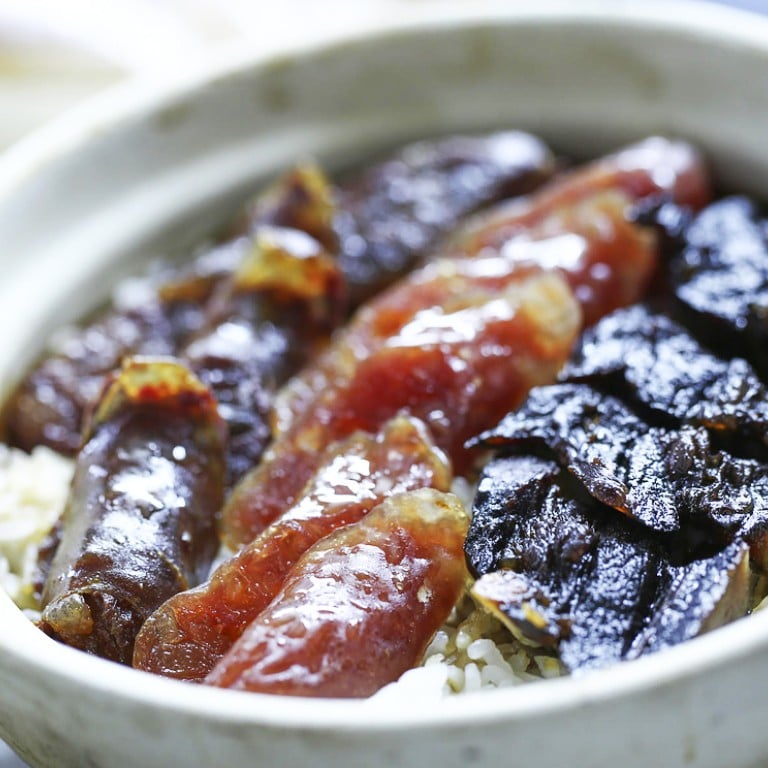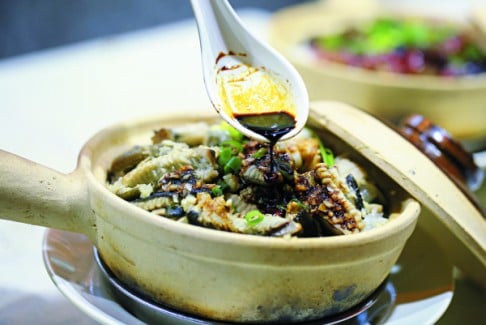
5 places to get your fill of Hong Kong's best claypot rice
As winter dishes appear on menus across the city, many Hongkongers look forward to the chance to tuck into warming claypot rice. Here are some of our favourites
A (coffee house) on Eastern Street in the 1970s, Wing Hop Sing is now better known for its claypot rice. Owner Hui Sung-chiu, who started his pastry-making career in his teens, added the dish to his menu to attract more customers, not knowing how popular it would become. To cater for the growing demand, he took the innovative step of cooking the claypot rice in a regular oven.
The family business moved to its current location in 1990 and the oven-cooked recipe came with them. Hui explains that it is much easier to control the temperature of a gas oven than over charcoal; the more consistent and evenly distributed heat means no more undercooked rice and burned bottoms. This method does not create a crunchy base, but if you pay an extra HK$10 during off-peak times, they will put the pot on a gas ring for a crunchy crust.

Their number one tip is to use a pair of chopsticks to fluff up the grains from the bottom instead of using a spoon to stir randomly, which makes the rice mushy. It is all about the rice: the toppings are cooked separately to prevent the top of the rice from becoming soggy, although with this method the flavours and juices of the meat are not fully incorporated into the rice.
Our favourite, also their bestseller, is the minced beef and egg claypot rice (HK$60). Cracked raw on top of the piping-hot rice, the egg oozes into the rice, giving it a richer texture. The expensive beef shoulder they use is well worth it because of its meatier flavour and firm-yet-tender texture. We love the mixed cured meat version (HK$73). The - especially the wine-laden pork and duck liver sausage, which they source from a vendor in Sheung Wan - is the best of the bunch.
This eatery is located in the cooked food area and is run by the relatively young Louis Chu Kam-wah. He's been in the restaurant business for 16 years and Siu Wah Kitchen has been in Shau Kei Wan for about five. Every year he thinks of new claypot rice combinations and this year came up with the idea of lobster and black truffles (HK$80). Another interesting choice is scallop and geoduck in black bean sauce (HK$65). We are intrigued with last year's creation: goose liver with wild mushroom (HK$65). Chu explains how the Thai rice is soaked for an hour to cut down on the cooking time (10 minutes), and he boils the rice in the claypot on gas rings, then adds the main ingredients before finishing it off over charcoal.


The goose liver is cut into small pieces and mixed with mushrooms for texture and to reduce the overall richness of the dish. When the claypot arrives at the table, we add the soy sauce and let it sit for a few minutes before eating it.
We also ordered the cured meat claypot rice (HK$65) and it was delicious. Chu also gets his cured meats from Sheung Wan, the district that houses the best cured meat purveyors in the city.
Although this 52-year-old cha chaan teng serves claypot rice all year round, it is best to pay a visit during winter. Lam Sing, who used to run the claypot rice section, and is now in his 70s and retired, returns to the shop during the peak season to help out.
The menu is simple and filled with old-school combinations including Jinhua ham with grass carp belly, (mandarin peel) with fish intestine, and shiitake with chicken. The shop relies on good relationships with long-term purveyors to provide them with the freshest and best ingredients.


From the rice (they use a mix of different aged Thai fragrant rice) to the mild sauce with a hint of wine, everything is prepared in-house. Owner Kong Fu-sing says he has no tips on how to make the best claypot rice - it all depends on the cook's experience and timing, ingredients that are not overcooked and a thin crust that is light and crisp.
Kong says they don't mind if guests ask them for a bowl of their wonton soup broth to add to their almost finished claypot before they scrape the crunchy bits from the sides of the pot.
Chef-owner Yu Ho-chuen prides himself on his claypot rice. Near the entrance to the kitchen is a large stainless steel stove-like contraption that has many holes to hold the claypots. They are covered with a metal lid with the main ingredients put on top so that the orders are not confused. The pots of rice are cooked using electricity and then when they are almost done, the ingredients are put on top and the pot is placed on a portable gas stove and tilted at an angle, which is shifted every few minutes.
"This is so the rice is evenly cooked on the sides, not just on the bottom," he says proudly.



Yu likes to use seafood from the nearby wet market in his dishes. The claypot rice with prawns (HK$78) comes with vermicelli, which he deftly removes from the steaming pot and places on a dish. Then he scoops the rice into individual bowls. The main event is watching him use a knife to loosen the crispy crust off the bowl - in one piece.
"The secret is having a very clean pot, but also to add a bit of oil to it," Yu says, adding that the crunchy treat can be eaten alone or as a dessert by sprinkling it with caster sugar.
The white eel rice (HK$85) here is delicous too - the meat is tender, if a little bony. All the claypot rice dishes come with boiled vegetables and a daily soup made with Chinese medicinal herbs. The recipes are from a Chinese medicine practitioner and the one we sample contains lingzhi mushrooms and corn.
This buzzing joint in the heart of Tai Po is the best place to get your late-night carb fix. A long queue of eager customers can be seen, waiting to devour well-priced claypot rice.
First gaining fame in Tsuen Wan with its beef brisket and steamed rice rolls, the congee and noodle specialist now sells more bo jai fan in winter than anything else. Look into the semi-open kitchen and you can see a neat row of claypots cooking.


The two-page menu dedicated to the dish boasts close to 60 varieties (HK$40-HK$70), the list is almost endless as they are basically endless combinations of ingredients that include frog, pork ribs, chicken, beef, preserved fish, two types of eel, and an assortment of cured meat. You can also pay an extra HK$5 to add an egg or a salted duck egg.
It is the little touches and attention to detail that make its food stand out. The house-made sauce infused with garlic oil (also made in-house) adds fragrance and complexity to the flavour. The mixed cured meat (HK$40) is diced instead of served in chunks so that each spoonful of rice comes with a nice mix of the preserved goodies. The yellow eel with frog rice (HK$60) was delicate, with the eel filleted in small pieces, and frog meat cooked perfectly.
Five more you will want to try
9-11 Shepherd Street, Tai Hang, tel: 3485 0501
46-58 Arthur Street, Yau Ma Tei
Wo Yick Mansion, 263 Queen's Road West, Sai Wan, tel: 2803 7209
30 Cochrane Street, Central, tel: 2543 1032
Tak Bo Garden, 3 Ngau Tau Kok Road, Kowloon Bay, tel: 2759 7096


